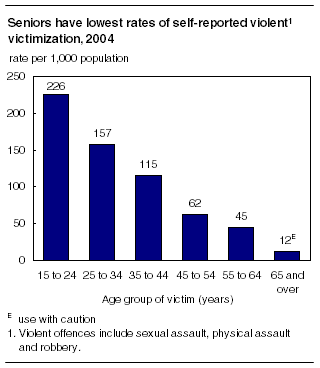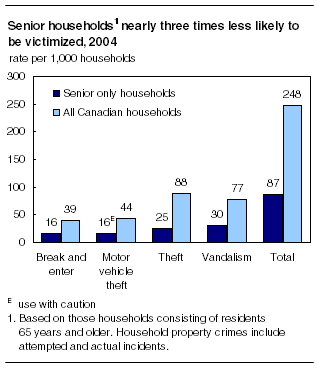Common menu bar links
Seniors as victims of crime
Archived Content
Information identified as archived is provided for reference, research or recordkeeping purposes. It is not subject to the Government of Canada Web Standards and has not been altered or updated since it was archived. Please "contact us" to request a format other than those available.

Canada's seniors (those aged 65 years and older) are less likely to be the victims of violent and property crimes than younger people, according to a new report.
The report is based on results from the 2004 General Social Survey (GSS) on victimization and police-reported data from the 2005 Uniform Crime Reporting (UCR) Survey. It examines the nature and prevalence of violent and property crimes against seniors, as well as fear of crime among seniors.
GSS data on victimization found that overall, 10% of people aged 65 and over were victimized in the 12 months preceding the survey, compared to 31% of those under 65 years of age.
Seniors were less likely to be the victims of violent incidents such as assault, sexual assault and robbery. The rate of violent victimization among seniors was almost four times lower than the rate for people aged 55 to 64, and almost 20 times lower than the rate for people aged 15 to 24. These findings are consistent with results from the previous cycle of the GSS survey on victimization conducted in 1999.

The latest police-reported data show that while senior victims (64%) and younger victims (69%) were both more likely to be victimized by someone known to them (such as a family member, a friend or an acquaintance), nearly half of senior victims were victimized by a family member, compared to 39% of younger victims. Just over one-third (35%) of perpetrators of family violence against seniors were adult children, and current or previous spouses were the perpetrators in 31% of incidents.
Seniors were no more likely to suffer injuries as a result of their victimization than were younger victims. According to police-reported data, 36% of senior victims and 38% of younger victims of violent crimes sustained an injury.
When an injury was sustained, it was most often minor in nature, requiring no professional medical treatment or only some first-aid. Overall, 2% of violent incidents committed against senior and younger victims alike resulted in major physical injuries.
Seniors were also less likely than their younger counterparts to be victims of personal theft of such items as money, credit cards or a purse/wallet. The rate among seniors for personal theft (22 incidents per 1,000 seniors) was less than half that of people aged 55 to 64 (51 incidents per 1,000 population), and almost eight times lower than the rate for young adults aged 15 to 24 (165 incidents per 1,000 population).

Households with only senior residents experienced household crimes (such as a break-in, property theft, motor vehicle theft or vandalism) at a rate of 87 incidents for every 1,000 senior households in Canada, nearly three times lower than the rate for all Canadian households (248 incidents per 1,000 households).
Seniors' satisfaction with their personal safety improved slightly between 1999 and 2004. The vast majority (92%) of seniors reported feeling satisfied with their overall level of safety from crime in 2004, compared to 89% reported in 1999. This increase closes the gap between seniors and younger Canadians, resulting in fairly consistent levels of satisfaction with their personal safety (92% compared to 94%).
Definitions, data sources and methods: survey numbers, including related surveys, 3302 and 4504.
The profile "Seniors as victims of crime" (85F0033MWE2007014, free) is now available as part of the Canadian Centre for Justice Statistics Profile Series. From the Publications module of our website, choose Free internet publications then Crime and justice.
For more information, or to enquire about concepts, methods or data quality of this release, contact Information and Client Services (toll-free 1-800-387-2231; 613-951-9023), Canadian Centre for Justice Statistics.

